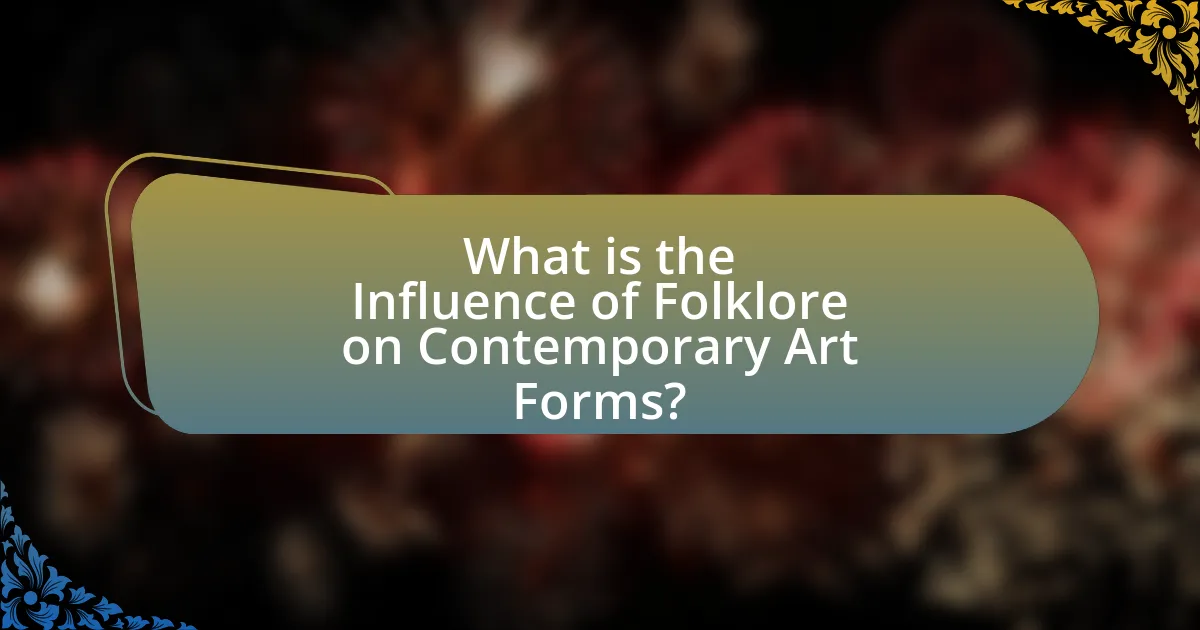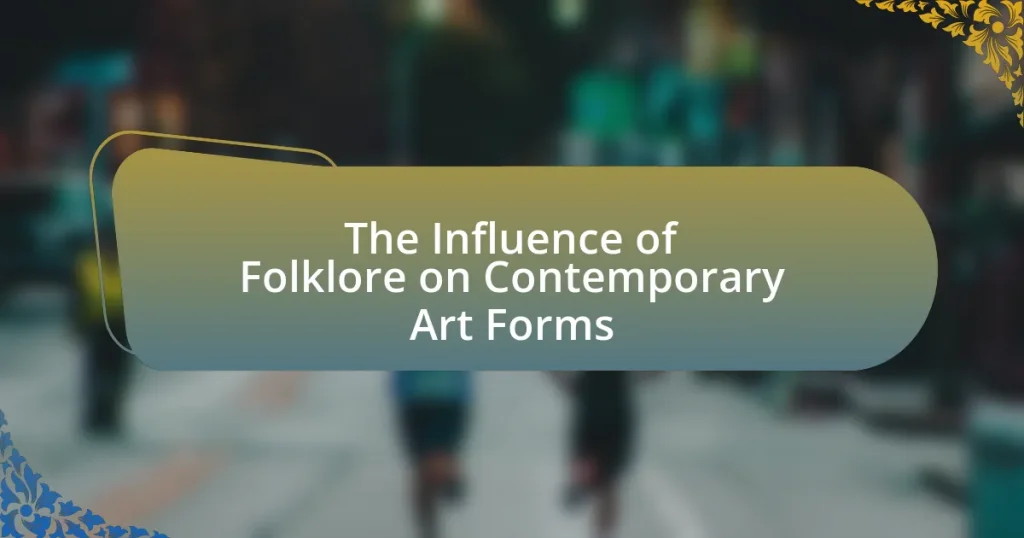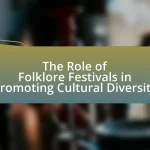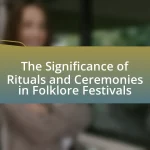The article examines the influence of folklore on contemporary art forms, highlighting how artists integrate traditional narratives, symbols, and cultural references into their work. It discusses the ways in which folklore shapes artistic expression, preserves cultural narratives, and fosters community engagement while addressing modern societal issues. Key elements such as storytelling, communal practices, and cultural symbols are explored, along with the challenges artists face regarding authenticity and cultural appropriation. The article also outlines best practices for artists to ensure respectful representation of folklore in their works, emphasizing the importance of research and community collaboration.

What is the Influence of Folklore on Contemporary Art Forms?
Folklore significantly influences contemporary art forms by providing rich narratives, symbols, and cultural references that artists incorporate into their work. This integration allows artists to explore themes of identity, tradition, and community, often reflecting societal issues through the lens of cultural heritage. For instance, artists like El Anatsui and Yinka Shonibare draw upon African folklore and history to comment on post-colonial identity and globalization. Additionally, the use of traditional techniques and motifs in modern practices, such as textile art and storytelling, demonstrates how folklore serves as a foundation for innovation in contemporary art. This blending of old and new not only preserves cultural narratives but also revitalizes them, making them relevant in today’s artistic discourse.
How does folklore shape artistic expression in modern contexts?
Folklore shapes artistic expression in modern contexts by providing a rich source of themes, narratives, and symbols that artists draw upon to connect with cultural heritage and identity. Contemporary artists often reinterpret traditional folklore elements, integrating them into various mediums such as visual arts, music, and literature, thereby creating a dialogue between past and present. For instance, the use of folklore in the works of artists like Yinka Shonibare and Kehinde Wiley illustrates how traditional stories and motifs can be recontextualized to address contemporary social issues, such as race and colonialism. This blending of folklore with modern artistic practices not only preserves cultural narratives but also allows for innovative expressions that resonate with diverse audiences today.
What are the key elements of folklore that influence contemporary art?
Key elements of folklore that influence contemporary art include traditional narratives, cultural symbols, and communal practices. Traditional narratives, such as myths and legends, provide rich storytelling frameworks that contemporary artists adapt to explore modern themes. Cultural symbols, including motifs and patterns from folklore, are often incorporated into visual art to evoke cultural identity and heritage. Communal practices, such as rituals and festivals, inspire collaborative art forms and performances, reflecting the social aspects of folklore. These elements are evident in the works of artists like El Anatsui, who integrates African textile traditions, and Yinka Shonibare, who uses Dutch wax fabric to comment on colonial history, demonstrating the ongoing relevance of folklore in contemporary artistic expression.
How do artists interpret folklore in their works?
Artists interpret folklore in their works by incorporating traditional narratives, symbols, and motifs that reflect cultural heritage and collective memory. This interpretation often manifests through visual art, music, literature, and performance, where artists draw upon specific folklore elements to convey deeper meanings or comment on contemporary issues. For instance, the use of indigenous myths in contemporary painting can serve to reclaim cultural identity and challenge colonial narratives, as seen in the works of artists like Frida Kahlo, who integrated Mexican folklore into her art to express personal and national identity. Such interpretations not only preserve folklore but also adapt it to resonate with modern audiences, thereby ensuring its relevance and continuity.
Why is the study of folklore important in understanding contemporary art?
The study of folklore is important in understanding contemporary art because it provides insight into cultural narratives and collective identities that shape artistic expression. Folklore encompasses traditional stories, customs, and practices that reflect the values and beliefs of a community, which contemporary artists often draw upon to create works that resonate with audiences on a deeper level. For instance, artists like El Anatsui incorporate traditional African textile techniques and storytelling into their installations, bridging the gap between historical context and modern interpretation. This connection highlights how folklore informs themes, aesthetics, and social commentary in contemporary art, making it essential for a comprehensive understanding of the field.
What cultural narratives are preserved through contemporary art?
Contemporary art preserves cultural narratives by reflecting and reinterpreting historical, social, and personal experiences through various mediums. This art form often incorporates elements of folklore, mythology, and traditional practices, allowing artists to convey stories that resonate with their cultural heritage. For instance, artists like El Anatsui utilize traditional African weaving techniques to comment on contemporary issues, thereby linking past narratives with present realities. Additionally, the use of indigenous symbols and motifs in contemporary works serves to maintain and revitalize cultural identities, as seen in the works of artists such as Frida Kahlo, who infused her art with Mexican folklore and personal history. These practices ensure that cultural narratives remain relevant and accessible, fostering a dialogue between generations and preserving the essence of cultural identities.
How does folklore contribute to the identity of contemporary artists?
Folklore significantly contributes to the identity of contemporary artists by providing a rich source of cultural narratives, symbols, and traditions that inform their creative expressions. Contemporary artists often draw upon folklore to explore themes of identity, heritage, and community, allowing them to connect with their cultural roots while also addressing modern societal issues. For instance, artists like El Anatsui incorporate traditional African textile techniques and storytelling into their work, bridging the gap between historical context and contemporary art practices. This integration of folklore not only enriches the artists’ work but also fosters a dialogue between past and present, enhancing their artistic identity and resonance with audiences.

What are the different forms of contemporary art influenced by folklore?
Contemporary art influenced by folklore manifests in various forms, including visual arts, performance art, and installation art. Visual arts often incorporate traditional motifs, symbols, and narratives from folklore, as seen in the works of artists like El Anatsui, who uses local materials to reflect cultural heritage. Performance art frequently draws on folklore through storytelling, rituals, and traditional dances, exemplified by artists such as Marina Abramović, who explores cultural narratives in her performances. Installation art can also reflect folklore by creating immersive environments that evoke cultural stories and practices, as demonstrated by artists like Yoko Ono, who integrates elements of Japanese folklore into her installations. These forms illustrate how contemporary artists reinterpret and preserve folklore, bridging the past with modern artistic expressions.
How do visual arts incorporate folklore elements?
Visual arts incorporate folklore elements by integrating traditional stories, symbols, and cultural practices into their visual representations. Artists often draw inspiration from local myths, legends, and community narratives, using motifs and themes that resonate with cultural identity. For instance, the use of indigenous patterns and storytelling techniques in contemporary paintings or sculptures reflects the heritage and beliefs of specific communities. This practice not only preserves cultural narratives but also revitalizes them within modern contexts, as seen in the works of artists like Frida Kahlo, who infused Mexican folklore into her art, thereby connecting personal experiences with broader cultural themes.
What techniques do artists use to blend folklore with modern visual styles?
Artists blend folklore with modern visual styles through techniques such as reinterpretation, mixed media, and digital manipulation. Reinterpretation involves taking traditional folklore themes and reimagining them within contemporary contexts, allowing for a dialogue between past and present. Mixed media combines various materials and techniques, such as painting, sculpture, and textiles, to create layered works that reflect both cultural heritage and modern aesthetics. Digital manipulation enables artists to incorporate folklore elements into digital art forms, enhancing accessibility and engagement with a broader audience. These techniques are evident in the works of artists like Yinka Shonibare, who uses Victorian dress and African textiles to explore colonial narratives, demonstrating the successful fusion of traditional and contemporary visual languages.
Which notable artists have successfully integrated folklore into their visual works?
Notable artists who have successfully integrated folklore into their visual works include Frida Kahlo, who drew heavily on Mexican folklore and indigenous culture in her paintings, and Yinka Shonibare, who explores themes of colonialism and identity through the lens of African folklore. Kahlo’s use of traditional symbols and narratives reflects her cultural heritage, while Shonibare’s work often incorporates Dutch wax fabric, linking African and European histories. These artists exemplify how folklore can enrich contemporary art by providing cultural context and depth.
In what ways does performance art draw from folklore traditions?
Performance art draws from folklore traditions through the incorporation of storytelling, rituals, and cultural symbols. Storytelling in performance art often mirrors the narrative techniques found in folklore, where artists convey cultural histories and communal experiences. Rituals, which are central to many folklore practices, are utilized in performance art to create immersive experiences that resonate with audiences on a personal and collective level. Additionally, cultural symbols from folklore are frequently employed in performance art to evoke specific meanings and emotions, connecting contemporary audiences to their cultural heritage. This blending of traditional elements with modern expression highlights the ongoing relevance of folklore in shaping artistic practices today.
How do storytelling and folklore enhance the impact of performance art?
Storytelling and folklore enhance the impact of performance art by providing rich narratives and cultural context that resonate with audiences. These elements create emotional connections, allowing viewers to engage more deeply with the performance. For instance, performance art that incorporates traditional folklore can evoke shared cultural memories, making the experience more relatable and meaningful. Research indicates that performances rooted in storytelling can increase audience retention and emotional response, as seen in studies like “The Role of Storytelling in Performance Art” by Smith and Johnson, which highlights how narratives can amplify the emotional weight of artistic expression.
What are the implications of folklore’s influence on contemporary art?
Folklore significantly influences contemporary art by providing a rich source of themes, narratives, and cultural identity. This influence manifests in various ways, such as the incorporation of traditional motifs, storytelling techniques, and community practices into modern artistic expressions. For instance, artists like El Anatsui draw on African folklore to create large-scale installations that reflect cultural heritage and social commentary. Additionally, the resurgence of interest in indigenous narratives within contemporary art highlights the importance of folklore in addressing historical injustices and fostering cultural resilience. This connection between folklore and contemporary art not only enriches the artistic landscape but also promotes a deeper understanding of cultural diversity and heritage in today’s globalized society.
How does folklore influence audience perception of contemporary art?
Folklore significantly influences audience perception of contemporary art by providing cultural context and emotional resonance. This connection allows viewers to interpret artworks through familiar narratives, symbols, and traditions rooted in their cultural heritage. For instance, artists like El Anatsui incorporate traditional African motifs and storytelling techniques, which evoke a sense of identity and collective memory among audiences. Research indicates that artworks referencing folklore can enhance viewer engagement and understanding, as seen in studies that show increased appreciation for art that resonates with personal or communal histories. Thus, folklore serves as a bridge between the artist’s intent and the audience’s interpretation, shaping how contemporary art is perceived and valued.
What role does cultural context play in the reception of folklore-inspired art?
Cultural context significantly influences the reception of folklore-inspired art by shaping the audience’s understanding and interpretation of the artwork. This context includes historical, social, and cultural factors that inform how viewers relate to the themes, symbols, and narratives presented in the art. For instance, artworks that draw on specific folklore traditions may resonate more deeply with audiences familiar with those traditions, as they can recognize and appreciate the cultural references embedded within the piece. Research indicates that art that aligns with the cultural values and experiences of its audience is often received more positively, as seen in studies examining the impact of cultural identity on artistic appreciation. Therefore, the cultural context not only enhances the relevance of folklore-inspired art but also affects its emotional and intellectual engagement with viewers.
How can folklore in art foster community engagement and cultural dialogue?
Folklore in art fosters community engagement and cultural dialogue by serving as a medium for shared narratives and collective identity. When artists incorporate folklore elements, they create relatable content that resonates with community members, encouraging participation and discussion. For instance, community murals that depict local legends or traditional stories can stimulate conversations about cultural heritage and shared values, thereby strengthening social bonds. Research indicates that art projects rooted in local folklore can increase community cohesion, as seen in initiatives like the “Art in the Park” program in Chicago, which utilized local folklore to engage residents and promote cultural exchange.
What challenges do artists face when incorporating folklore into their work?
Artists face several challenges when incorporating folklore into their work, primarily related to authenticity, cultural appropriation, and audience reception. Authenticity is crucial, as artists must ensure that they accurately represent the folklore’s origins and meanings, which often requires extensive research and understanding of cultural contexts. Cultural appropriation poses a significant risk, as artists may unintentionally exploit or misrepresent the traditions of marginalized communities, leading to backlash and ethical concerns. Additionally, audience reception can be unpredictable; some viewers may appreciate the integration of folklore, while others may reject it if they perceive it as inauthentic or superficial. These challenges highlight the delicate balance artists must maintain when drawing from rich cultural narratives.
How can artists navigate cultural appropriation concerns in their practice?
Artists can navigate cultural appropriation concerns by engaging in thorough research and fostering genuine collaborations with the cultures they draw inspiration from. This approach ensures that artists understand the historical and social contexts of the cultural elements they wish to incorporate, thereby respecting the source culture. For instance, artists can participate in community dialogues and seek permission or guidance from cultural representatives, which not only validates their work but also promotes cultural exchange. Additionally, artists should critically assess their motivations and the potential impact of their work on the source community, ensuring that their practice does not exploit or misrepresent the culture. This method aligns with the growing emphasis on ethical practices in art, as seen in initiatives that advocate for cultural sensitivity and awareness.
What best practices can artists follow when integrating folklore into contemporary art?
Artists can follow several best practices when integrating folklore into contemporary art, including thorough research, respectful representation, and community engagement. Conducting in-depth research allows artists to understand the cultural significance and historical context of the folklore they wish to incorporate, ensuring authenticity. Respectful representation involves portraying folklore in a way that honors its origins and avoids stereotypes or misinterpretations, which is crucial for maintaining cultural integrity. Additionally, engaging with the communities from which the folklore originates fosters collaboration and provides valuable insights, enhancing the artwork’s depth and relevance. These practices are supported by examples of successful contemporary artists who have effectively integrated folklore while maintaining respect for its cultural roots.
How can artists ensure respectful representation of folklore in their works?
Artists can ensure respectful representation of folklore in their works by engaging with the communities from which the folklore originates. This engagement involves conducting thorough research, understanding the cultural significance of the folklore, and collaborating with cultural custodians to accurately depict traditions and narratives. For instance, artists can reference the work of scholars like Barbara Kirshenblatt-Gimblett, who emphasizes the importance of cultural context in her studies on performance and representation. By prioritizing authenticity and sensitivity, artists can avoid appropriation and misrepresentation, thereby honoring the heritage and values embedded in the folklore.
What resources are available for artists to study folklore effectively?
Artists can effectively study folklore through a variety of resources, including academic journals, books, online databases, and workshops. Academic journals such as “Folklore” and “Journal of American Folklore” provide peer-reviewed articles that explore various aspects of folklore, while books like “The Study of Folklore” by Alan Dundes offer foundational knowledge. Online databases, such as JSTOR and Project MUSE, grant access to a wealth of scholarly articles and research papers. Additionally, workshops and seminars hosted by organizations like the American Folklife Center provide hands-on experiences and expert insights into folklore practices. These resources collectively enhance artists’ understanding and application of folklore in their contemporary art forms.















